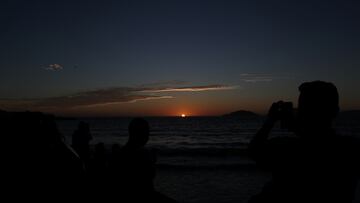Why do colours look different during a solar eclipse?
During today’s total solar eclipse, the way we perceive colours will change - a phenomenon that’s known as the Purkinje effect.


People in the path of today’s total solar eclipse, which will begin to cross the United States in the early afternoon, can expect to observe a shift in how they perceive colours.
“Greens and blues will pop”
In bright conditions, colours like red and orange appear much more vibrant to the human eye than colours such as blue and green. However, in dim light - such as the conditions we experience at dusk or during a solar eclipse - this changes. As eclipse totality approaches today, the opthalmologist Dr. Nicole Bajic explains to Accuweather, “you might see that the reds appear kind of dark, and the greens and blues will pop in contrast”
This change in colour perception is known as the Purkinje effect, a phenomenon named after the Czech anatomist Jan Evangelista Purkinje. It comes down to how our eyes pick up light.
Eyes use two types of light-sensitive receptors: cone-based, photopic receptors for well-lit conditions; and rod-based, scotopic receptors in low light. As daylight fades every evening, the cones gradually pass the baton over to the rods. For a brief period during this handover phase, as our eyes adjust to the changing light, the cones and rods work together, in what is known as mesopic vision.
Why does mesopic vision lead to Purkinje effect?
When cones and rods have to work simultaneously, they end up in direct competition to get signals to the brain. “Rods and cones don’t have separate signal pathways to the brain,” Jay Neitz, a professor of ophthalmology at the University of Washington, tells Scientific American. “So information from both of them converges on the very same set of fibers that are linked to our brains.”
Signals from cones that perceive red are lost, but those from cones that pick up blue and green are not. This, allied with the fact that rods are more sensitive to blue and green, is why our perception of colours undergoes a shift.
Nighttime-vision rods “not ready to take over”
While mesopic vision is something that takes place in our eyes on a daily basis as it gets dark, the speed with which the light shifts during a solar eclipse makes our experience of the Purkinje effect so much more pronounced than usual.
Normally, the rods have longer to gear up as daylight slowly dims - a process called ‘dark adaption’ - and require less collaboration with the cones. But when the light changes suddenly in an eclipse, the rods are “not ready to take over yet, because they haven’t dark-adapted”, Bajic says.
Related stories
Neitz adds: “Every day it goes from being bright outside to dark at night over a period of a couple hours […] it’s so gradual that our rods have already begun to adjust, so we hardly even notice there’s something kind of amazing going on.”
We want you to watch the total solar #eclipse. We just don't want it to be the last thing you see.
— NASA (@NASA) April 5, 2024
How to watch safely: https://t.co/E1wDcSjF4P
April 8 livestream: https://t.co/1c4ystgCfm pic.twitter.com/rjpREhQU3b
When and where is the total solar eclipse?
According to NASA, today’s total solar eclipse will enter the US in Texas, before moving through Oklahoma, Arkansas, Missouri, Illinois, Kentucky, Indiana, Ohio, Pennsylvania, New York, Vermont, New Hampshire, and Maine. In Dallas, Texas, totality is due to begin at 2:40pm ET, while Caribou, Maine will experience totality from 3:32pm ET.
Complete your personal details to comment